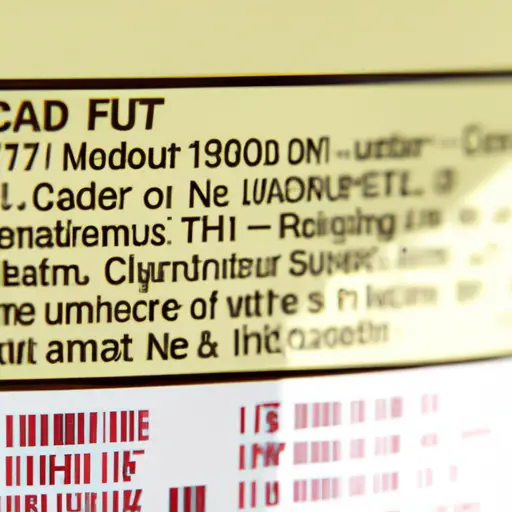Uncovering Heart Health Benefits of High-Fiber Diets
Get Healthy with a High-Fiber Diet
Hi there, welcome to my blog! Are you tired of feeling sluggish, bloated, and unsatisfied after meals? Well, I have some good news for you. Adopting a high-fiber diet can improve your health in numerous ways!
But what exactly is a high-fiber diet? Simply put, it’s a diet that is rich in whole plant foods such as fruits, vegetables, legumes, nuts, and seeds. These foods are all excellent sources of dietary fiber.
So what are some of the benefits of a high-fiber diet? Well, for starters, it can improve your heart health. Studies have shown that consuming a high-fiber diet can help to lower cholesterol levels, reduce blood pressure, and decrease your risk of heart disease. Additionally, a high-fiber diet can help with weight management, lower your risk of certain types of cancer, improve digestive health, and more!
What’s the Deal with Fiber Anyway?
So, you may have heard that fiber is important for a healthy diet, but what exactly is it? Fiber is a type of carbohydrate that the body can’t digest or absorb. Instead, it passes through the digestive system relatively intact, providing a number of beneficial effects along the way.
There are two main types of dietary fiber: soluble and insoluble. Soluble fibers dissolve in water and form a gel-like substance that helps to slow down the digestive process. Insoluble fibers, on the other hand, do not dissolve in water and pass through the digestive system largely unchanged.

Both types of fiber provide important health benefits and should be included in a well-rounded diet. Soluble fiber has been shown to help lower cholesterol and regulate blood sugar levels, while insoluble fiber helps to keep the digestive system running smoothly and can reduce the risk of certain types of cancer.
Heart-Healthy Benefits of High-Fiber Diets
Let me tell you, a high-fiber diet can do wonders for your heart health! Not only can it lower your cholesterol, but it can also reduce your blood pressure and decrease your risk of cardiovascular disease. According to a study linked to the American Heart Association, individuals with higher fiber intakes had a 40% lower risk of heart disease than those who consumed less.
You may be wondering how fiber can have such a powerful impact on heart health. Essentially, soluble fiber found in foods like oats, beans, and fruits works by binding to cholesterol and removing it from your body. In addition, both soluble and insoluble fiber help to keep your blood vessels healthy and flexible, reducing your risk of hypertension.
The best part? Incorporating more fiber into your diet is relatively simple! Start by swapping refined grains for whole grains, adding in more veggies and fruits, and snacking on nuts and seeds. Aim for at least 25 grams of fiber per day for women and 38 grams for men. Trust me, your heart will thank you! For some serious inspiration, take a look at Lovely Life of Leah’s blog on the advantages of eating high fiber foods.
So, don’t wait any longer – start working towards a heart-healthy lifestyle by increasing your fiber intake today!
4. How to Up Your Fiber Game!
Okay folks, now that we know all the amazing benefits of a high-fiber diet, it’s time to figure out how to actually make it happen in our daily lives. Don’t worry, it’s not as hard as you might think. Let’s dive in!
The first step is to add more fruits and vegetables to your meals. These are great sources of fiber and can easily be incorporated into any meal. Try adding some berries to your breakfast or eating a salad with your lunch. You can also snack on vegetables like carrot sticks and bell peppers throughout the day.
Another easy way to increase your fiber intake is to choose whole grain versions of your favorite foods. Switch from white rice to brown rice, eat whole wheat bread instead of white bread, and choose whole grain cereals over sugary alternatives.
If you’re struggling to get enough fiber from your diet alone, you can also consider taking a fiber supplement. Look for one that is made from natural sources like psyllium husk or acacia fiber.
It’s important to note that when you increase your fiber intake, you also need to increase your water intake. Fiber absorbs water, so if you don’t drink enough water, you could end up constipated. Make sure you’re drinking plenty of water throughout the day.
Finally, don’t try to increase your fiber intake all at once. This can cause digestive discomfort and might turn you off from continuing your high-fiber diet. Gradually increase your fiber intake over a few weeks to give your body time to adjust.
There you have it, folks! With these easy tips, you can start reaping all the amazing health benefits of a high-fiber diet. Let’s get our fiber on!
High-Fiber Diets: The Ultimate Recipe for Long-term Health
In conclusion, adopting a high-fiber diet is an excellent way to improve overall health and protect against various diseases. High-fiber diets provide a wide range of benefits for the body, including improved digestion, weight control, and a lower risk of diabetes and heart disease.
To increase your fiber intake, add more whole grains, fruits, and vegetables to your diet. Aim for at least 25 to 30 grams of fiber every day and be sure to drink plenty of water. Gradual changes to your diet will help you adjust to the increase in fiber and reduce the risk of digestive problems.
While a high-fiber diet is generally safe and healthy, it’s always vital to speak with your healthcare provider before making any significant dietary changes.
Don’t wait until you have health issues to start a high-fiber diet. Incorporate more fiber-rich foods into your meals gradually. Over time, you will feel healthier, more energetic, and enjoy the added benefits of a happy gut and a sound heart.






